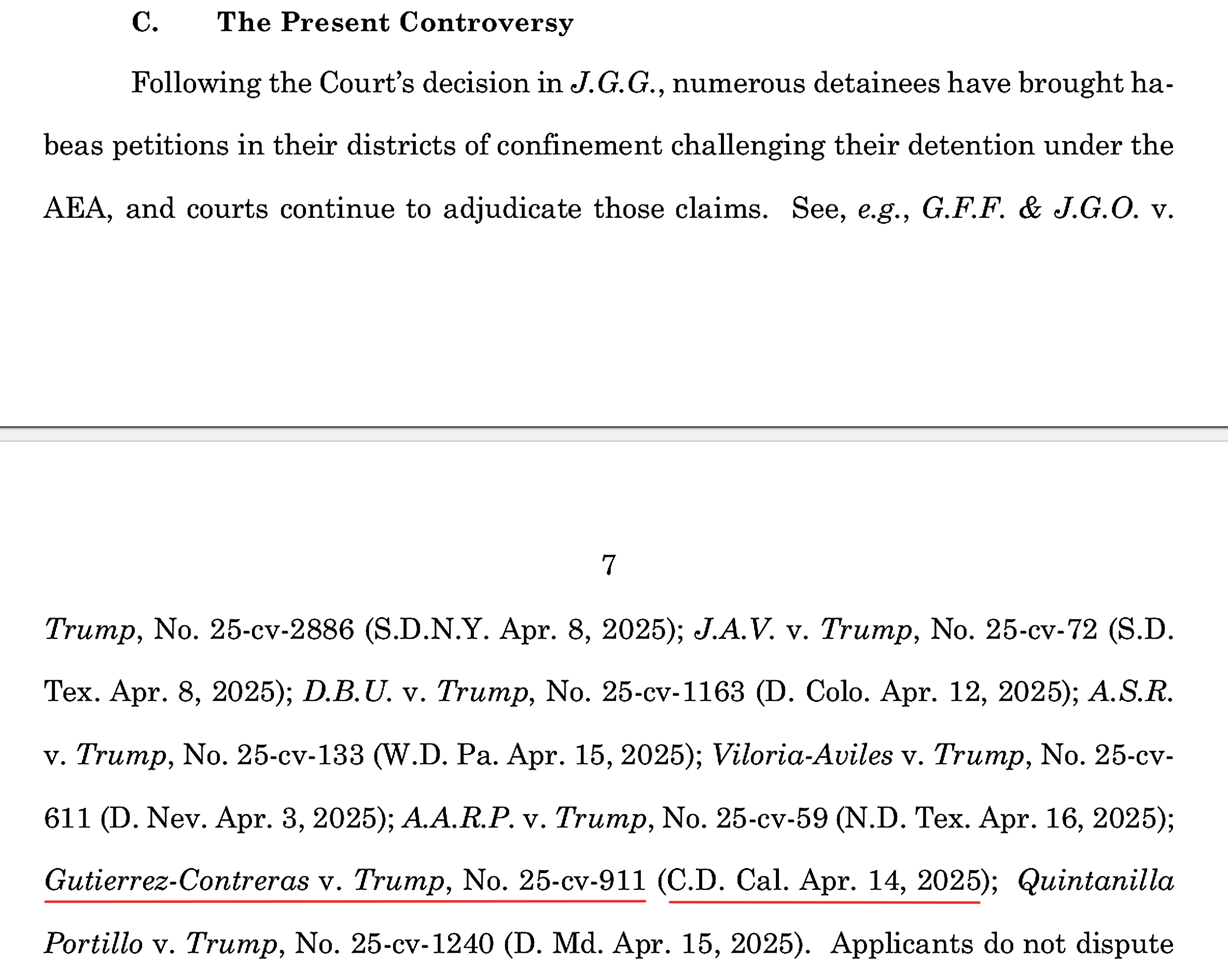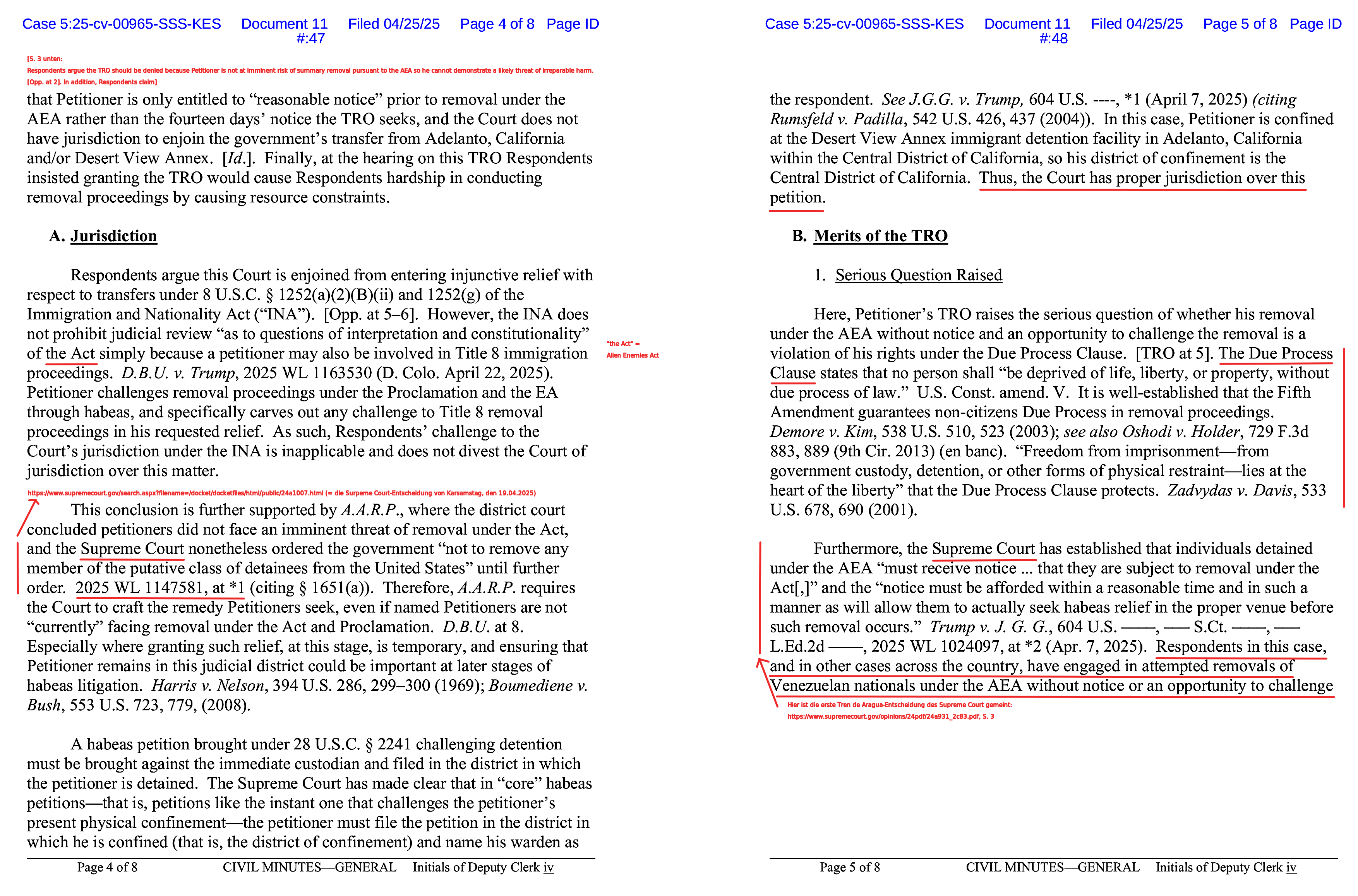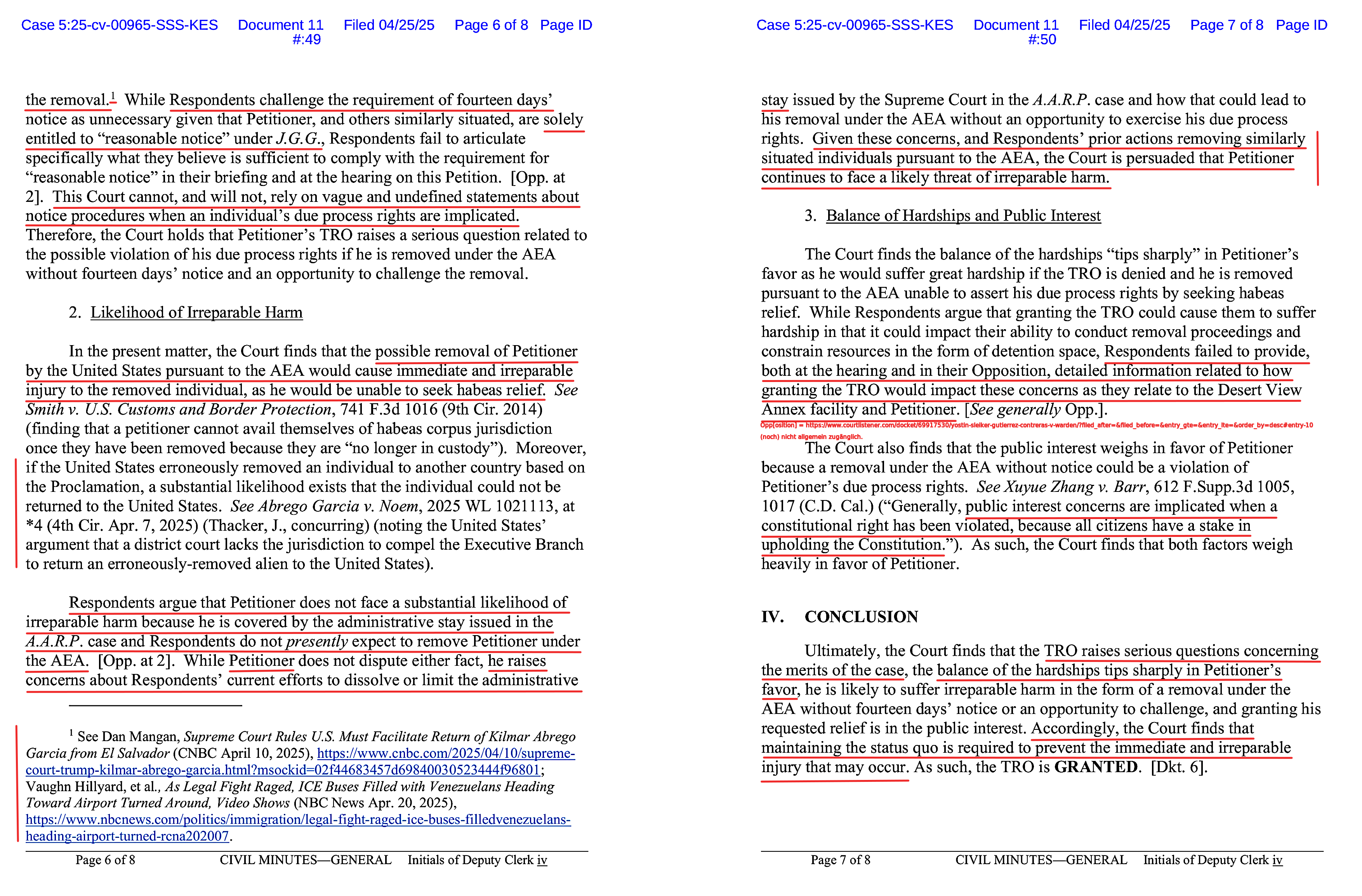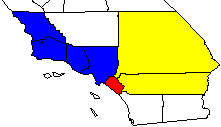Gestern hat District Court für den Central District of California zugunsten des dortigen Antragstellers entschieden:
„Respondents [= US-Regierung] are ordered to provide fourteen days’ notice to Petitioner and his counsel, in writing, prior to attempting to remove, deport, or expel him out of the United States under the Alien Enemies Act or any legal authority other than the Immigration and Nationality Act. Respondents are enjoined and barred from removing Petitioner under the Alien Enemies Act or any legal authority other than the Immigration and Nationality Act without first providing such notice„.
(https://storage.courtlistener.com/recap/gov.uscourts.cacd.967089/gov.uscourts.cacd.967089.11.0.pdf, S. 8; Hv. hinzugefügt)
1. Der Fall, um den es hier geht, war bereits in dem Regierungs-Schriftsatz für das zweite TdA-Verfahren vor dem US-Supreme Court erwähnt (vgl. taz-Blogs vom 20.04.2025):

https://www.supremecourt.gov/DocketPDF/24/24A1007/356072/20250419170105032_A.A.R.P.%20Opp.%20FINAL.pdf, S. 6 f. der gedruckten bzw. 8 f. der digitalen Seitenzählung
Das erste zentral-kalifornische Verfahren
2. Am 14. April waren ein habeas-Antrag und ein TRO-Antrag eingereicht worden.
3. Am 16. April gewährte der District Court für den Central District of California den beantragten ‚Eil-Eil-Rechtsschutz‘ (Temporary Restraining Order) (https://storage.courtlistener.com/recap/gov.uscourts.cacd.965963/gov.uscourts.cacd.965963.7.0.pdf [4 Seiten] und am nächsten Tag folgte – auf Antrag – eine Klarstellung (https://storage.courtlistener.com/recap/gov.uscourts.cacd.965963/gov.uscourts.cacd.965963.10.0.pdf [2 Seiten]). Noch einen Tag später erfolgte eine Korrektur (https://storage.courtlistener.com/recap/gov.uscourts.cacd.965963/gov.uscourts.cacd.965963.13.0.pdf [4 Seiten; siehe dort S. 2]). [Vgl. taz-Blogs vom 17.04.2025:
„am Mittwoch gewährte aber der District Court für den Central District of California in einem neuen – vierten [nach Süd-New York, Südtexas und Colorado] – Verfahren vorläufigen Rechtsschutz (https://t1p.de/qkhzf via Gosh Gerstein [Politico]; vgl. https://t1p.de/h1v4t)“.]
4. Ebenfalls am 18.04. beantragte die Regierung die Aufhebung der TRO – anscheinend da der Betroffene schon bei Einreichung des Antrages von Kalifornien nach Texas verlegt worden sei und das Gericht in Kalifornien daher nicht zuständig sei (so jedenfalls die Darstellung des Antragstellers [https://storage.courtlistener.com/recap/gov.uscourts.cacd.967089/gov.uscourts.cacd.967089.1.0.pdf, S. 1 bzw. 3: „Respondents claim that the prior petition suffers a jurisdiction flaw because Respondents removed Petitioner from this district hours before that petition was filed“]); Erwiderung des Antragstellers: https://t1p.de/zsdnq.
5. In dem ersten zentralkalifornischen Verfahren sind (bisher) nur die Entscheidungen des Gerichts, aber (noch) nicht die Schriftsätze der Verfahrensbeteiligten allgemein zugänglich.
Das zweite zentral-kalifornische Verfahren
6. Sodann wurde der Betroffene aber zurück nach Kalifornien verlegt, und es wurden neue Anträge (TRO-Antrag [noch noch nicht allgemein zugänglich] und habeas-Petition) beim District Court für den Central District of California eingereicht:
„Respondents have since returned Petitioner to Central District of California, and undersigned counsel has taken reasonable measures to confirm that he is present in this district now—at the time of this filing. Although Petitioner contends that his return to California moots any jurisdictional problem with the prior petition, he nonetheless files this petition as a safeguard to ensure that this Court retains jurisdiction. With Petitioner undisputedly present in immigration custody in the Central District of California, there can now be no dispute that venue is proper and that the Court can properly exercise jurisdiction over Petitioner’s case.
Petitioner does not take this belt-and-suspenders approach lightly, but finds it necessary given the immense issues at stake and the fact that the government has moved to dismiss the prior petition on jurisdictional grounds. Petitioner is willing to proceed however the Court deems most efficient, including by consolidating this petition with the prior petition. If the government agrees to waive its jurisdictional objection to the prior petition“.
(https://storage.courtlistener.com/recap/gov.uscourts.cacd.967089/gov.uscourts.cacd.967089.1.0.pdf, S. 1 der gedruckten bzw. 3 der digitalen Seitenzählung)
7. Gestern (Freitag, den 25.04.) fand eine mündliche Verhandlung statt (vgl. https://t1p.de/ubibd, https://t1p.de/tgqjz sowie https://t1p.de/qqqlc) und wurde vom Gericht eine neue TRO erlassen, die diesmal etwas ausführlich als die erste begründet ist:


https://storage.courtlistener.com/recap/gov.uscourts.cacd.967089/gov.uscourts.cacd.967089.11.0.pdf (8 Seiten)
8. Die Regierung hatte – nach Darstellung des Gerichts – vor allem zwei Argumente vorgebracht:
a) „In addition, Respondents claim that Petitioner is only entitled to ‚reasonable notice‘ prior to removal under the AEA rather than the fourteen days’ notice the TRO seeks, and the Court does not have jurisdiction to enjoin the government’s transfer from Adelanto, California and/or Desert View Annex.“
b) „Respondents argue the TRO should be denied because Petitioner is not at imminent risk of summary removal pursuant to the AEA so he cannot demonstrate a likely threat of irreparable harm.“
9. Zu Argument b) bezieht sich das das Gericht auf die Supreme Court-Entscheidung von Karsamstag. Im dortigen Falle hatte sich der District Court der Auffassung der Regierung angeschlossen, daß keine unmittelbare Abschiebung drohe, der Supreme Court aber
„nonetheless ordered the government ’not to remove any member of the putative class of detainees from the United States‘ until further order.“
Daher sei das Gericht verpflichtet,
„to craft the remedy Petitioners seek, even if named Petitioners are not ‚currently‘ facing removal under the Act and Proclamation.“
Zwar sei der Antragsteller im Moment zusätzlich von der Surpeme Court-Entscheidung geschützt, da er zum Zeitpunkt der Einleitung des Verfahrens in Nord-Texas (nur auf diesen Gerichtsbezirk bezieht sich die Supreme Court-Entscheidung de jure) inhaftiert war. Da aber die Regierung die Aufhebung oder zumindest Einschränkung der Supreme Court-Entscheidung beantragt hat, sei dieser Schutz nicht ausreichend:
„Petitioner […] raises concerns about Respondents’ current efforts to dissolve or limit the administrative stay issued by the Supreme Court in the A.A.R.P. case and how that could lead to his removal under the AEA without an opportunity to exercise his due process rights. Given these concerns, and Respondents’ prior actions removing similarly situated individuals pursuant to the AEA, the Court is persuaded that Petitioner continues to face a likely threat of irreparable harm.“
Dabei ist zu beachten, daß die Regierung vor dem Supreme Court in erster Linie argumentiert, daß die Supreme Court-Entscheidung voreilig gewesen sei (nicht, daß sie in der Sache falsch sei). Das heißt: Eine Aufhebung oder Einschränkung der Supreme Court-Entscheidung würde nicht (notwendigweise) heißen, daß in den nordtexanischen Fällen alles in Ordnung war und eine Rechtshelfsfrist von weniger als 24 Stunden in Ordnung wäre.
Damit sind wird bei Argument a) der Regierung („Petitioner is only entitled to ‚reasonable notice‘ prior to removal under the AEA rather than the fourteen days’ notice the TRO seeks“). Dazu sagt der District Court für den Central District of California:
„While Respondents challenge the requirement of fourteen days’ notice as unnecessary given that Petitioner, and others similarly situated, are solely entitled to ‚reasonable notice” under J.G.G., Respondents fail to articulate specifically what they believe is sufficient to comply with the requirement for ‚reasonable notice‘ in their briefing and at the hearing on this Petition. [Opp. at 2]. This Court cannot, and will not, rely on vague and undefined statements about notice procedures when an individual’s due process rights are implicated.“
(In dem südtexanischen Verfahren, in dem bereits am Donnerstag eine weitere Entscheidung ergangenen war [s. taz-Blogs vom 25.04.2025], hatte sich die Regierung dagegen genauer zu der Frist, die sie zu gewähren bereit ist, geäußert:
„Although there may be fact-specific exceptional cases, in a general case, after an alien is served with Form AEA 21-B, the alien is given a reasonable amount of time, and no less than 12 hours, including the ability to make a telephone call, to indicate or express an intent to file a habeas petition. If the alien does not express any such intention, then ICE may proceed with the removal, though such removal may not actually occur for many more hours or days, giving the alien additional time to express an intent. If the alien does express an intent to file a habeas petition, the alien is given a reasonable amount of time, and no less than 24 hours, to actually file that petition. If the alien does not file such a petition within 24 hours, then ICE may proceed with the removal, though such removal may not actually occur for many more hours or days, giving the alien additional time to file the petition. Further, because aliens subject to the AEA are often detained for several days before removal, they frequently have much more time to express an intent to file a habeas petition or to actually file such a petition.“
[https://storage.courtlistener.com/recap/gov.uscourts.txsd.2000771/gov.uscourts.txsd.2000771.49.0_2.pdf, S. 3, Nr. 11; Hyperlink hinzugefügt]
Die Regierung hält also anscheinend eine Rechtsbehelfsfrist von sagenhaften 2 x 12 Stunden für ausreichend: 12 Stunden um die Einlegung des Rechtsbehelfs anzukündigen und dann weitere 12 Stunden (oder vielleicht auch 12 + 24 Stunden), um den Rechtsbehelf tatsächlich einzulegen – aber auch dies nur „in a general case“. Der – von Trump nominierte – südtexanische Richter hält diese Frist anscheinend nicht für ausreichend und hat seine TRO am Donnerstag verlängert.)
10. a) Auf die Frage, ob überhaupt die Voraussetzungen für eine Anwendung des Alien Enemies Act („declared war between the United States and any foreign nation or government, or any invasion or predatory incursion is perpetrated, attempted, or threatened against the territory of the United States by any foreign nation or government“) gegeben sind, geht der District Court für den Central District of California bisher nicht ein.
b) Ein Antrag auch andere in Zentralkalifornien von der Tren de Aragua-Proklamation Betroffene zu schützen, wurden in dem dortigen Verfahren bisher nicht gestellt.
11. Das Gericht legte am Freitag folgende Fristen für das weitere Verfahren fest:
„This Order shall be in effect until May 10, 2025. The Court ORDERS Respondents TO SHOW CAUSE as to why a preliminary injunction should not issue. Respondents shall file any response by Friday May 2, 2025, and Plaintiff shall file any reply by noon on Wednesday May 7, 2025. The Court SETS a hearing in person on whether a preliminary injunction should issue on May 9, 2025, at 1 P.M.“
(https://storage.courtlistener.com/recap/gov.uscourts.cacd.967089/gov.uscourts.cacd.967089.11.0.pdf, S. 8)
Das erste zentralkalifornische Verfahren:
Yostin Sleiker Gutierrez-Contreras v. Warden Desert View Annex (5:25-cv-00911)
District Court, C.D. California
https://www.courtlistener.com/docket/69891354/yostin-sleiker-gutierrez-contreras-v-warden-desert-view-annex
Das zweite zentralkalifornische Verfahren:
Yostin Sleiker Gutierrez-Contreras v. Warden (5:25-cv-00965)
District Court, C.D. California
https://www.courtlistener.com/docket/69917530/yostin-sleiker-gutierrez-contreras-v-warden/



